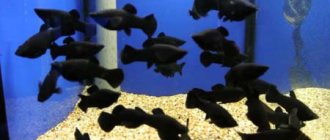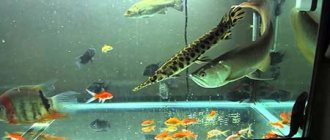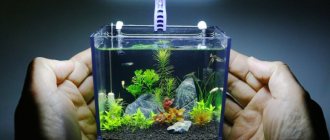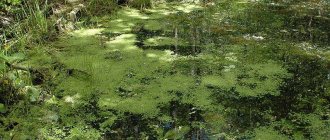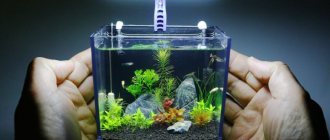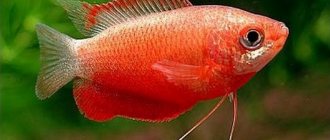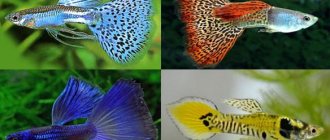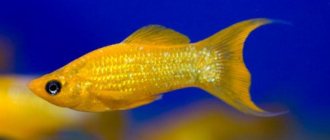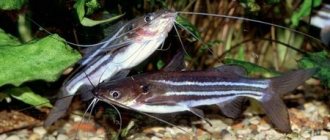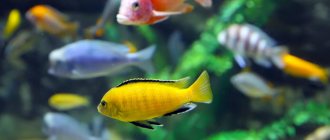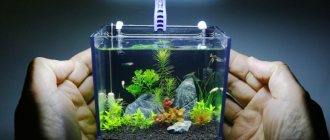In nature, there are many fish without bright colors, which allows them to successfully hunt or hide from predators. But dull and gray inhabitants are unlikely to decorate an aquarium. That is why breeders have been selecting and preserving the most striking representatives with an unusual body shape and fins for decades. And we have achieved significant success in this. Selective breeding has allowed modern aquarists to choose their pets from a wide variety of colors and shapes. In this article we will tell you about the most beautiful aquarium fish , so that everyone can decide who to put in the aquarium based on their own preferences.
The most beautiful aquarium fish
On a note ! Each fish is beautiful in its own way, but we still managed to make a rating of the TOP 20 most attractive, in our opinion, inhabitants of the aquarium.
Handsome Chromis
Handsome Chromis
This fish is a real pearl among African cichlids. In many countries it is also called the “jewel cichlid.” The body color of the fish is really gorgeous! Her body is bright red, with many bluish-green dots scattered throughout it, shimmering in the reflected light no worse than precious stones. In suitable conditions, chromis can grow up to 15 cm in length. The optimal volume of an aquarium for a pair of fish is at least 60 liters. As for compatibility, Chromis has problems with it: his character, to put it mildly, is not sweet, there is a pronounced territoriality .
The best aquarium catfish
Catfish are one of the most popular inhabitants of aquariums. In addition to a wide variety of species and unpretentiousness in breeding, these fish are also useful: they clean the bottom and walls of the home, eat leftover food and prevent plants from growing excessively.
Synodontis - catfish for a large aquarium
5
★★★★★
editorial assessment
100%
buyers recommend this product
See review▶
Synodontis catfish are also called changelings or cuckoos. Their body size ranges from 10 to 30 cm depending on the variety and size of the aquarium. The main features that unite all skinwalkers are a large scaleless body, laterally compressed, and a color with dark spots. Catfish spend most of their time at the bottom or on the very surface of the water, where they swim with their belly up. With proper care, catfish live up to 15 years.
Due to their large size, synodontis should be placed in large aquariums. One individual needs at least 50 liters of water. For a comfortable existence, they also need snags, thickets or other shelters where the fish can hide. Comfortable water temperature for this species is 23-28 degrees. Catfish prefer to live in schools of 4-6 individuals. Synodontis eats everything that gets into the aquarium, so it is not recommended to stock it with small fish - the catfish can snack on them in search of food. It is friendly towards large species.
Pros:
- lives up to 15 years;
- undemanding to water quality and temperature;
- thoroughly cleans the soil and walls of the aquarium;
- can be housed with most other fish species;
- not picky about food.
Minuses:
- not suitable for small aquariums.
Changelings love to dig the soil, so all plants need to be firmly supported. They also often raise turbidity from the bottom, which only a powerful filter can remove.
Pangasius is the most unusual catfish for large aquariums
4.9
★★★★★
editorial assessment
95%
buyers recommend this product
See review▶
Pangasius is a large fish, resembling a shark in shape and color, which is why it received its second name - shark catfish. In nature it reaches 130 cm, in aquariums it sometimes grows to 100 cm. The species is a long-liver and pleases its owners for up to 20 years.
Pangasius does not need special care. The main condition for its comfort is a reservoir with a volume of at least 1200 liters. The catfish cohabits peacefully with all the fish that it cannot eat. It is not recommended to house it with small species. Pangasius can live in almost any water, as long as it is clean.
Pros:
- unusual appearance;
- lives up to 20 years;
- peaceful character;
- undemanding to water parameters;
- easy care.
Minuses:
- difficult to find on sale;
- eats small fish;
- you need a very large aquarium.
Catfish have delicate skin, so the soil and decorations in the aquarium must be carefully selected, checking that there are no sharp corners that could injure the pangasius.
Pterygoplicht brocade - the most beautiful catfish
4.9
★★★★★
editorial assessment
90%
buyers recommend this product
See review▶
Pterygoplicht brocade is a leopard-print catfish. Its body is covered with small dark spots, and a beautiful fluffy fin up to 15 cm high rises on top. This is a fairly large fish - its body length can reach 50 cm, so it is not advisable to put it in small aquariums. It eats algae in large quantities, thanks to which a couple of such catfish can keep large bodies of water clean. Pterygoplichthus is a real long-liver. In nature, it lives up to 20 years, in aquariums - on average 10-15 years.
Catfish easily get along with any fish, are not aggressive, but at night they can eat the scales of flat fish. Angelfish, discus and other slow fish are not the best companions for him. Caring for a catfish is not difficult - you just need to feed it and clean the aquarium on time. For such a large pet, it is better to install a high-quality filter. Recommended water temperature is from 24 to 30 degrees.
Pros:
- effectively cleans the aquarium;
- long-lived;
- not aggressive;
- beautiful view;
- easy care.
Minuses:
- Suitable for large aquariums only;
- eats the scales of some fish.
Pterygoplichtha brocade is sold when it is still small, and it grows quite slowly. This can be confusing for an inexperienced aquarist. However, sooner or later the catfish will grow out of a small body of water. The ideal aquarium volume for it should be at least 400 liters.
Tarakatum is the best aquarium cleaner
4.9
★★★★★
editorial assessment
89%
buyers recommend this product
See review▶
Tarakatum catfish is a frequent inhabitant of small aquariums. Its laterally flattened body reaches a length of 10-14 cm. The color is from light brown to brown with dark spots. Like all catfish, it is nocturnal, inactive during the day and prefers to hide under snags or in plants. He shows no interest in other fish, regardless of their size. The main thing is that they do not invade its bottom territory.
In nature, cockroaches live for about 5-6 years, but in aquariums with proper care - up to 10. It is recommended to keep several of these catfish - they prefer to live in flocks. For catfish, aquariums with a spacious, wide bottom and an abundance of plants that create dark, secluded areas are ideal.
Pros:
- peaceful;
- suitable for small aquariums;
- lives up to 10 years;
- thoroughly cleans the bottom.
Minuses:
- does not get along with other bottom fish.
An aquarium with a cockroach must be covered with a lid, since there are frequent cases of them jumping out of the water. The soil should be smooth and not too shallow. If it is selected incorrectly, the catfish's whiskers may fall off.
READ ALSO
9 Best Aquarium Lamps
Frontosa
Frontosa
Frontosa is one of the most charming cichlids of Lake Tanganyika. The body length can reach 30 cm, and therefore the volume of the aquarium for keeping must be at least 300 liters. The frontosa has a large and massive body, and a fatty growth is located above the head (in males it is larger). But the most attractive thing is the stunning coloring, which is an alternation of wide dark and light stripes. There are several geographical species , differing in color intensity, location and number of stripes.
Note ! Frontoz's neighbors in the aquarium should only be comparable species of fish, since everything that fits into the mouth will most likely be eaten.
Sumatran barb (Barbus tetrazona)
Schooling fish are in constant motion, and therefore they are real activators of water.
The mobile aquarium inhabitants have an original color of black stripes along a silvery body, and the fins have a red border.
Sumatran barbs can pester other fish, but living in a school, the barbs are busy with each other and leave other inhabitants of the reservoir alone.
12
Princess of Burundi
Princess of Burundi
Princess of Burundi (another name is Neolamprologus Brishara) lives in the waters of Lake Tanganyika in Africa. It was not by chance that this peace-loving fish was named princess. It has a very elegant elongated body, a lyre-shaped tail and veil fins with pointed tips. The body size does not exceed 10 cm. To keep a group of neolamprologus, you need an aquarium with a volume of 130 liters or more.
The Princess of Burundi's coloring may seem modest, but if you look closely, you'll notice some interesting details. The scales of the fish are pinkish-white, with yellow speckles. The mosaic pattern at the bottom of the head has a blue tint, and a black stripe runs from the gill cover to the edge of the eyes. Another feature is the blue edging of all fins.
“Women’s stockings” – zebrafish
Thanks to their bright colors, these fish look impressive and attractive. Their homeland is the countries of the East, where zebrafish live in small bodies of water.
In Europe they appeared at the beginning of the 20th century, and in our country even later. Zebrafish, pearl zebrafish, firefly zebrafish, dangila zebrafish, and pink zebrafish have gained particular popularity.
Danio has quite a large number of species, but they all have a characteristic feature - horizontal stripes on the body. For this they were nicknamed “women’s stockings.”
Danios are fidgety animals that are famous for their incredible jumping ability. This is why the fish aquarium must be covered.
And so that the fish do not hit the surface of the lid while playing, you need to leave 5 cm of free space.
Colored pets feel great in water +18-24°C. They love light, so the aquarium should be placed in a well-lit place.
The peaceful nature allows zebrafish to be housed together with swordtails, neons, and gouramis. Snails and even shrimp can be good neighbors. However, keeping zebrafish with aggressive fish species and some veiled fish is strictly prohibited.
Cockerel
Cockerels
A distinctive feature of Siamese cockerels is not only their quarrelsome temperament, but also their excellent appearance. The body size is on average 5 cm, but if you add the size of the fins of some breeds, the figure can be doubled. Breeders have bred over 70 breeds of cockerels, which differ in color and shape of fins. There are white, pink, red, blue, emerald, and black specimens on sale.
According to the shape of the cockerel's tail, there are:
- deltatails;
- crown-tailed;
- double-tailed, etc.
On a note ! It turns out that everyone can choose a fish to their liking. It is better to keep males alone or in the company of a female. The volume of the aquarium is at least 20 liters.
How many fish should I stock?
Universal rules for determining quantity.
- The aquarium population is selected based on the net volume of water. 10–15% of the space spent on decorations, plants and soil are not taken into account.
- Large fish are placed in a spacious aquarium. For small, active and social animals you will need a container of 40 liters or more.
- The calculation is based on oxygen exchange. If there are plants and additional sources of oxygen, then the number of inhabitants of the aquarium increases. To dissolve oxygen, the water temperature rises. Overpopulation is indicated by the concentration of fish near the surface even with good aeration.
- The larger the fish, the more waste it produces. To determine the permissible number of inhabitants, measure the level of nitrogen compounds and impurities in the water. Water tests are purchased at pet stores.
- In a mixed-sex aquarium, the number of females is 2-3 times greater than males.
On a note ! These recommendations do not take into account the characteristics of individual representatives. Each aquarist must select the number of fish himself, monitoring the behavior of his fish and creating the maximum level of comfort for them.
We are talking about the most unpretentious aquarium fish
Nothobranchius
Nothobranchius
Among the spawning carp-toothed fish there are very beautiful fish, the body color of which resembles the pattern of orchid flowers. The life cycle of the African species of Nothobranchius is closely related to the rainy and dry seasons. With the onset of the rainy season, these fish emerge from eggs , and then, quickly reaching sexual maturity, spawn until the very beginning of the drought. Moreover, the eggs can be in the hibernation stage for up to 6 months. Therefore, the life of nothobranchius is very short, despite even being kept at home. However, the fish are still very popular due to their stunning colors.
Angelfish (Pterophyllum)
The Latin name of this beautiful fish comes from two Greek words “wing” and “leaf”. Indeed, the original body shape resembles these two objects.
Keeping angelfish requires a tall aquarium with large-leaved plants. This type of fish holds the record for life expectancy in captivity. Some individuals live up to 10 years.
10
Red neon
Red Neon
Red Neons are often found in aquascapes , as these small fish are the most beautiful representatives of the Characin family. The peculiarity of red neons is 2 red stripes running along the entire body (one is bright red and the other is blue, with a characteristic neon glow).
The body size does not exceed 5 cm. The fish are kept in schools, and the larger the group, the better it looks. Neons get along well with peace-loving fish and living plants.
Nannakara neon
Neon Nannakara
A very unusual fish, the appearance of which is still not known for sure. According to experts, this is a hybrid , the result of crossing some American cichlids.
If you take a closer look at Nannakara, it will immediately become clear why it is so popular among aquarists. The fish has bright blue scales with a golden-pearl sheen. A well-developed dorsal fin stretches from the tail to the head and has a yellow edging on top. The body size is on average 13 cm, the required aquarium volume for a couple is from 100 liters. Nannakars are quite peaceful and hardy.
Sexual characteristics
Caramel thorns spawn in pairs. You can choose a female and a male in a school of fish based on characteristics that are clearly visible in a comparison of body structure. Females are larger and wider. Their abdomen is more rounded. The fins are also different: the anal fin has the shape of a wide skirt, the dorsal fin is higher and sharper than the fin of the male individual.
Female and male Ternetia vulgare
The male is smaller in size, has a more flattened body shape, the dorsal fin is not so high and has a rounded shape, the anal fin has a rounded shape and looks more neat than that of the female.
Macropod
Macropod
One of the first aquarium fish to become widespread due to its beautiful appearance and good endurance was macropods. They grow up to 10 cm, have an elongated body and developed unpaired fins. The length of the lyre-shaped caudal fin can reach 3 cm. The color deserves special attention: the body is olive or blue with many transverse stripes.
On a note ! The volume of the aquarium for macropods is from 40 liters. The fish has a fighting character; it gets along with a limited number of species (especially in a small aquarium).
Main types of aquarium fish
In nature, there are a myriad of fish species, which are constantly replenished with hybrids and selected specimens. All representatives are divided into groups united by common characteristics.
| Family | Description | Representatives |
| Atherine | Elongated body shape with an elongated head. Color is multi-colored. The food is varied (vegetation, livestock, dry food). There are nuances in care that should be taken into account when preparing the aquarium. Peace-loving. | Red, two-color, Black Sea, Ladigesi. |
| Carp | The body is covered with scales, monochromatic. Omnivores (dry, frozen, live, canned). Unpretentious, suitable for beginners. They live in flocks. The character is flexible and gets along easily with other representatives. | Goldfish, zebrafish, labeo, barb, cardinal. |
| carp-toothed | Bright, colorful small fish (less than 10 cm). The diet consists of live food. There are no difficulties in the content. Neighbors are chosen that are large and live at other levels in the aquarium. There is an aggressive attitude. | Notobranchius: gunther, rakhova, jubbie, courthouse; Afiosemions: amieta, striatum, two-stripe, southern, filamentosum, gardner. |
| Labyrinthine (creeper-shaped) | They got their name due to their respiratory organ, which helps obtain oxygen from the atmosphere. Oblong body, compressed at the sides, small head. Multicolor representatives. The diet consists of 30% live food, the rest is omnivorous. They adapt to any living conditions, the main thing is access to oxygen. Each species has its own reaction to its neighbors. | Pineapple, cockerel, gourami, lalius, labiosa. |
| Poeciliaceae | Small fish live in schools. Wide variety of colors. The diet contains fiber. Not demanding on the maintenance of the aquarium. Suitable for beginners. There are peace-loving and aggressive representatives. | Guppies, swordtail, mollies, platies, girardinus. |
| Pomacentral | They have an oval body with flattened sides. Variegated multi-colored color. They are divided into those that feed on plants and live food. They love to feast on polyps. Whimsical fish. They are aggressive towards members of their own species and are indifferent towards others. | Amphiprion, chrysipterus, zebra dascillus, dascillus, garibaldia, clownfish. |
| Rainbows | Large schooling fish. The body is long, laterally compressed. They can be single-color (red, brown, olive) or two-color (blue and yellow). They feed on plant and animal foods. There are peculiarities in care. Peace-loving. | Melanothenia: Boesman, Parkinson's, three-stripe, neon, turquoise. |
| Catfish | Covered with skin, some representatives have a protective layer of bone plates. The sides and fins are equipped with spines for protection, and the head has whiskers for exploring the environment. The body is oddly shaped. The color is varied, mainly gray, brown, dark tones. They feed on leftover food and are herbivores. Sometimes there are predatory representatives. They are not demanding in terms of care and are considered the “orderlies” of aquariums. They are not aggressive, but can attack relatives. They are threatened by other large fish. | Agamix, pterygoplichthus, ancistrus, corydoras. |
| Characinaceae | The family has great diversity, from the smallest to the giants. There are pale and bright individuals. The diet includes everything, depending on the species. There are herbivores and carnivores. There are certain requirements when setting up an aquarium and maintaining it. Neighbors are treated differently. | Neon, erythrozonus, ternetia, ornatus, serpas, tetra. |
| Cichlids | One of the largest species of vertebrate fish. The size and shape of the body have a wide range of changes. These are mainly medium-sized fish with an oval body and pressed sides. The color is rich and bright. Omnivores (carnivores, herbivores, mixed diet). Care requires compliance with certain conditions to create a comfortable living environment. The character is peaceful, sometimes cocky. Some species can be aggressive. | Apistograms: ramiresi, Bolivian butterfly; Agassian, cockatoo; American: angelfish, discus, meeka, diamondback, black-striped; African: frontosa, lionhead, johani. |
Lyalius
Lalius
A small labyrinth fish that can decorate any tropical aquarium. Lalius clearly exhibits sexual dimorphism: females are of no value in terms of beauty (like most other species), but males will never be left without attention. Their silver body is covered with red and blue luminous stripes (although there are breeding forms with other color options). Over the course of evolution, the pectoral fins have become thin, sensitive filaments .
The body size of the lalius is 6-7.5 cm. A large aquarium is not needed - 40 liters is enough. Lalius are compatible with most ornamental fish of the same size.
TOP 35 aquarium fish
Popularity includes the prevalence of the species, ease of care, maintenance, breeding, and accessibility. When choosing instances, the compatibility factor should be taken into account. The list below includes fish that are in demand.
Ancistrus
The smallest of the aquarium catfish. Its inconspicuous appearance does not reduce the merits of this fish, since it is a cleaner that actively maintains the balance of the biological environment of the reservoir.
Stickers have an unusual mouth structure in the form of a suction cup. Thanks to it, they feed on the remains of algae and collect them from the walls. Unpretentious in care.
Temperature range +20…+28 °C, pH 6.0-7.3. Hiding in snags. Herbivores do not require additional food. Easy to breed. The downside is that they chase small fish and can harm scaleless ones. The 80 liter aquarium is designed for a couple of catfish. Beginners can safely get such pets.
Read more in the article about Ancistrus catfish.
Astronotus
Powerful oval body with a large head and large thick lips. The size of the fish in an aquarium is 20-25 cm, in nature they grow up to 35 cm. The color range is varied: from red to marble.
Astronotus are kept in pairs in a large aquarium. They are unpretentious in food, omnivorous, but prefer animal food (earthworms, shrimp, mussels, grasshoppers, small fish like guppies). It is added to the diet with high-quality dry food.
Choose a large aquarium (from 400 liters per couple). The bottom is lined with sand. If vegetation is added, then with hard leaves.
Temperature in the range of +22…+26 °C, pH 6.5-7.5. Once a week, change 20% of the water and clean the soil from food debris. The container is equipped with aeration and kept closed so that the fish do not jump out. They can get along with other species, but will require a larger tank. By nature they are predators and can attack; they choose large neighbors. Not suitable for beginner aquarists.
Barbus
Small schooling fish up to 12 cm long with an elongated oblong body and variegated color. Several representatives are placed in a spacious aquarium at once. Capable of existing at temperatures of +20...+25 °C, pH 6.0-8.0.
Little algae is planted, only as a shelter. They love to swim and need space. The soil is filled with natural dark soil (pebbles, gravel). Once every two weeks, 1/5 of the water is renewed.
Additional aeration and filtration are carried out, and an artificial flow is created. The food is balanced and varied. Plant food makes up 30% (spinach, nettle, dandelion) of the total menu. Three times a month add ground boiled egg yolk. Alternate between dry, frozen and live diets. They are placed with active, assertive inhabitants. It is difficult to get along with sedentary species. Almost all types of barbs are suitable for beginner hobbyists.
Botia clown
The fish are medium-sized, 15-20 cm long, with vertical black and orange stripes throughout the body. The antennae located near the mouth are designed to search for food. They are populated in small groups, the aquarium is chosen with a volume of 350-400 liters.
Water temperature +24…+30 °C, pH 6.0-6.5. Soft sand is used as soil and decorated with driftwood and plants. They will serve as shelter.
They change some of the water once a week and clean out the trash every day. Omnivorous, they choose food by sinking or get food from the bottom. Single individuals show aggression. A difficult fish to keep, it requires the experience of an aquarist.
Botia modesta
Solid gray-blue fish with a red tail and fins. The size of an adult reaches 20-25 cm. They live in flocks. The aquarium is selected at the rate of 200 liters for 5 representatives.
The temperature is maintained at +23…+28 °C, pH 6.5-7.5. Water is enriched with oxygen through aeration. 1/3 of the total volume is changed weekly. Organic waste is cleaned daily. Decorate with rooting algae.
Eating like a clown. Calm and peaceful when in a pack. Not suitable for beginners in aquarium keeping.
Botia marble
A small silvery fish covered with black vertical stripes. Its body length is 6-7 cm. At the mouth there are antennae for searching for food. They are cowardly by nature.
The flock is placed in an aquarium with established parameters, temperature +24...+30 °C, pH 6.0-6.5. They love different hiding places. They lead an active lifestyle at night. The soil is soft. An external filter and aeration are installed in an artificial reservoir.
The water is changed once a week and cleaned daily of food debris and excrement. They feed from the bottom and are omnivorous. The fish are fed in the evening; they choose sinking food and prefer live food (bloodworms, tubifex).
Do not share with large, aggressive inhabitants. Due to the nature of its contents, it is not recommended for beginning aquarists.
Guppy
One of the most popular types of aquarium fish, suitable even for beginners. They are small in size, do not require a large spacious container to live in, and will feel comfortable even in a three-liter jar.
Male guppies are brightly colored, with a veil-like tail. There are usually 3-4 females per male. The female specimen is slightly larger in size and has a dull color.
Life expectancy is two to four years. During this time, they manage to produce offspring up to 8 times, despite the fact that a mature female is capable of giving birth to up to 100 fry at a time. Unpretentious to living conditions and food. The temperature in the aquarium varies from +19 to +29 °C, but they prefer warm water +22...+25 °C, pH 7.0-8.5. Omnivores. Friendly. They are not added to large predators.
Read more in the article all about guppies.
Marbled gourami
Large, reaching 15 cm. Pearlescent color with small spots. They do not require special care. Can be kept by beginner aquarists. Capable of existing in small aquariums as long as size allows.
Adults require a large volume (at least 80 l). Water temperature +23…+26 °C, pH 6.1-6.8.
They are omnivores, but their diet must include live food. Capable of overeating if fed out of proportion. There are no difficulties in breeding. They populate in pairs, otherwise the males will fight among themselves. After spawning, the female is placed separately so that the male does not kill her while he guards the eggs. They are peaceful and rarely attack other inhabitants.
Danio
Schooling fish. It is recommended to move at least 6 units at once. They have a bright crimson or blue color. Small, the largest individuals reach 5 cm in size. Life expectancy is 3 years.
They like to swim in schools. Because of this feature, it is preferable to choose a flat, wide aquarium with sparse, low vegetation.
Another feature of the species is that zebrafish are big fans of jumping out of the water. Therefore, choose a high lid with an internal recess of 3-4 cm and keep it closed at all times.
They are unpretentious in care. Temperature conditions can vary in the range of +16…+28 °C, pH 6.0-8.0. Requires good lighting. Omnivorous. It is better to purchase food in the form of flakes so that individuals can eat from the surface of the water. Get along well with other species. Recommended for beginners for their first aquarium.
Discus
Variegated fish with an unusual disc-shaped body, grow from 15 to 25 cm in length. They are prone to stress and disease due to weak immunity. Choose long, tall aquariums from 250 liters. They are characterized by a high temperature of +28…+31 °C, pH 6.0-6.5.
Be sure to provide an external filter, and often carry out partial water changes. They siphon the soil daily. They feed on animal food, dry food, minced meat or fish.
Friendly. They are kept in flocks of 6 or more and cannot tolerate loneliness. Due to the peculiarities, it is difficult to find neighbors.
Not every experienced professional is capable of keeping such a fish; this is perhaps the most difficult species in the aquarium hobby.
gold fish
A bright underwater inhabitant, there are many varieties, but the most spectacular and easiest to care for is the natural one - the golden one. As the name suggests, the color is yellow-orange.
For comfortable keeping they require a wide aquarium of 40-80 liters per individual. Water is changed once a week in an amount of 10-15% of the total volume. A powerful filter is a must. The temperature may vary; long-bodied ones feel best at +17...+25 °C, short-bodied ones at +21...+29 °C, pH 6.9-7.2. The main rule is the absence of sudden changes.
They can live for a week feeding on algae. The food is pre-soaked, and the portion is carefully monitored so as not to add too much. The fish suffer from overeating. With good care and nutrition they can live up to 25 years. Undemanding, suitable for beginners in aquarium keeping.
Corridoras
Active inhabitants of the bottom are small in size (7 cm). They feed on the leftover food of other fish. Rarely require additional feeding. They live in flocks and like to hide in shelters.
Unpretentious to conditions. For 5-8 representatives, choose a 50 liter aquarium with a temperature of +20...+30 °C, pH 5.8-7.8. Suitable for breeding. Beginners can do them. Good-natured.
Redtail catfish
Large aquarium predator. It grows up to 130 cm. The body is dark gray, with a white stripe stretching the entire length from the mouth to the tail. The caudal fin and the top of the dorsal fin are bright scarlet.
The aquarium is spacious and wide. The catfish is located at the bottom. Sedentary. The soil chosen is soft (sand, flat stones) or not covered at all. The temperature is maintained at +20…+26 °C, pH 5.5-7.2. Unpretentious to living conditions.
The main thing is that all devices (filter, aeration, heater) are installed outside so that the occupant cannot tear them down or break them.
Produce a lot of waste. Prone to obesity. A young individual is fed daily; for an adult, the frequency is reduced, sometimes up to once a week. The diet is varied. It is not recommended to eat mammalian meat. Most often, other catfish or cichlids are chosen as neighbors. It can swallow small representatives, although it is peaceful. Due to its gigantic size, it is not recommended for beginners.
Crossocheilus
The Siamese algae eater has a silver color with a black horizontal stripe running across the entire length of the body, the size of which is up to 15 cm. They are kept in aquariums of 100 liters or more, creating natural conditions simulating rivers with strong currents.
They decorate with driftwood, stones, and plant seaweed with wide leaves. Temperature +23…+26 °C, pH 6.0-7.5. The aquarium must be covered with a lid because of the love of jumping. They are fed a varied diet with the obligatory content of vegetables (spinach, zucchini, cucumber), scalded with boiling water. Accommodating, but they are not added to veiled ones because of their predilection for their fins.
Not worth starting for beginners.
Lyalius
Small fish with an elongated body and compressed sides, large fins. Males of Lalius grow up to 7-8 cm, have a variegated color: the body is silver, covered with red and blue stripes, the abdomen is lilac. Females are more modestly colored. They reach 5-6 cm in length and are pale.
Maintenance is easy. They live near the surface of the water, but can swim in all layers. For one representative, a 10-liter aquarium with water at room temperature +23...+28 °C, pH 6.0-8.0 is enough.
Shy, love shelter. The vegetation is planted densely and floating species are added. They eat all food (live, frozen, dry). From time to time, breeders organize fasting days to avoid obesity. It is not recommended to feed bloodworms. They settle with friendly medium-sized individuals. Large predators can scare them. Suitable for beginners in aquarium keeping.
Macropod
A motley blue fish with bright red stripes. The body is elongated, the fins are sharp. Males grow up to 10 cm, females are smaller - up to 8 cm.
An aquarium is purchased based on 20 liters of water per representative; for a couple, 40 liters or more are provided. They tolerate different temperatures from +16 to + 26 °C, pH 6.5-8.0.
The filter is installed so as not to create a strong current. The container must be covered with a lid; the fish may jump out. They prefer live and frozen food. Feeding is carried out 2 times a day in small portions. They are similar in character to cockerels; they can be placed with large, non-aggressive fish or kept separately. Suitable for beginners.
sword bearer
The diversity of representatives of this species is amazing. They have bright colors and small sizes. Females are large - 12 cm, males are slightly smaller. They are unpretentious when it comes to food; it is recommended to alternate between dry and live food.
Wide temperature range from +18 to +28 °C, ideally +23...+25 °C, pH 6.8-7.8.
It is not recommended to populate a large number of males; they are pugnacious and, if there are not enough females, they will fight. There are 2 females for every male.
Life expectancy is 5 years. The downside is that they prefer large, wide aquariums (at least 50 liters). They don’t add males to fish with veiled tails; they pluck out their tails. The main safety rule is to keep the lid closed. Swordtails are big fans of jumping. A favorite type for beginners.
Read more in the article about swordtails.
Black mollies
Selected species of mollies. It reaches 6-10 cm in length. From the name it is clear that it is black. Choose a medium aquarium so that the fish are not crowded. 60 l will do. The water can be added with salt, but only if there are no neighbors.
Temperature range +23…+28 °C, pH 7.0-8.0. The breeder chooses the design independently. They require a lot of light and greenery.
They are unpretentious in food. The diet must contain plant fiber, which can be obtained from plants and vegetables. They get along well with other types of fish, except aggressive predators. Easy to maintain for beginners.
Molliesia velifera
The largest species of mollies. Females grow up to 14 cm in length, males are slightly smaller - up to 12 cm. Dim silver color. The aquarium is kept in schools of 7-10 fish and does not break into pairs. Therefore, choose containers of 50 liters or more.
The temperature is maintained at +23…+28 °C, pH 7.0-8.5. It is preferable to use fine dark soil to highlight the beauty of the mollies. They are unpretentious in decor. It is enough to plant a couple of green bushes and install driftwood.
Feeding principles are similar to black mollies. Friendly fish. This type of underwater inhabitants is suitable for beginner aquarists.
We recommend reading the article about mollies.
Neon
Small fish with a slender body 4 cm long. With a multi-colored blue-red color. They live in packs. They are started in an established aquarium with a water temperature of +22…+26 °C, pH 6.8-7.0. For cleaning, install a filter and change 25% of the water weekly.
When designing, it is worth considering that they are shy and it is necessary to organize places for shelters. They eat all types of food, the main thing is to choose small food. They get along well with other representatives and can become lunch for predators.
Suitable for experienced aquarists only.
Oranda
A representative of the species is a goldfish with an ovoid body, veil-shaped fins, and a tail. Dimensions vary from 7 to 18 cm. Color varies from black to golden, depending on the variety.
When choosing an aquarium, take into account that one individual has up to 50 liters of water. The temperature is set to +18…+23 °C, but does not drop below +16 °C, pH 6.0-8.0. To prevent the fish from getting hurt, the soil chosen is not sharp, and the plants are populated with smooth leaves. They establish cleaning and aeration.
They feed on a mixture of live and dry food. Friendly, with an easy-going character. Do not add them to fish that can bite their fins or tail (cockerels, mollies, swordtails, etc.). Undemanding in content.
Pangasius
A representative of the catfish family with the body of a shark, it grows up to 100 cm in length. The color is dark, predominantly gray with mother-of-pearl.
For such fish you need an appropriate aquarium. For a young representative, 300-400 liters is enough; as they grow, the volume is increased; large individuals are kept at 1200 liters.
Temperature +22…+26 °C, not sensitive to acidity and hardness. Change 1/3 of the water weekly. Mixed meals, small portions, 2-3 times a day. Young animals live in flocks; as they age, they prefer solitude. They are introduced to large fish that the catfish cannot swallow. This predator should only be handled by aquarium professionals.
Cockerel
Unusual, beautiful, fighting fish with multi-colored colors. Named for their mottled tail. It is not recommended to place two or more males in one container. The size of the male individual is 6-10 cm. Females are slightly smaller in size and lack beautiful fins.
There are no difficulties in care. They feel comfortable even in a not very large aquarium, the main thing is access to atmospheric air and a clean surface of the reservoir. Temperature range +24…+28 °C, pH 6.0-8.0. They do not tolerate sudden changes well.
They are omnivorous and prone to overeating. Jumpers. They live 3-4 years. Do not mix with veiled fish and fish that can tear off fins and tails. Easy to maintain in the absence of slow-moving species.
More interesting things about the cockerel.
Pecilia
Small pets with a body length of 3.5-5 cm. The palette of shades is varied. They are kept in 40-50 liter aquariums separately from other species. When living together, take larger containers.
Comfortable temperature +22…+25 °C, pH 7.0-8.3. Cleaning and aeration are installed as desired. The main thing is to update 20% of the water weekly.
Like most fish, they are omnivores and require plant fiber. The diet is varied. They get along well with other fish, but can serve as prey for predators.
They practically do not differ in care from swordtails and are suitable for beginners.
Also read the article about platies.
Pterygoplichthus
Brocade catfish is a long-lived aquarium catfish. Previously called Glyptopterychthus. Able to live 10-15 years. It grows up to 50 cm in length, with a distinctive feature of a 15 cm dorsal fin. The body is elongated, covered with bony plates, except for the abdomen. The color is dark, spotted.
Aquariums are chosen to be spacious, from 100 liters. Water temperature +24…+30 °C, pH 6.5-7.5. 25% of the total volume is renewed weekly. A diet where 80% is plant food, 20% is live food is ideal. It is better to take frozen animal food. Catfish pick up leftover food from the bottom.
It is not recommended to keep goldfish, the conditions of detention are different. They get along well with large fish, be it a predator or an omnivore. Not recommended for beginners.
Synodontis eupterus
A representative of the catfish, it is called veil-shaped, which it received for its fins. Body length 15-20 cm, color dim, spotted.
It is not fussy about maintenance, daily cleaning of the soil, weekly change of 10-15% of water. Choose a large aquarium, at least 200 liters. Water temperature +22…+27 °C, pH 5.6-7.5. Equipped with various shelters and plants with hard leaves. The soil is chosen to be sandy so that the catfish does not damage its antennae.
Any type of food will do. Peace-loving, but loves to bully. They live in flocks, where there is a hierarchy in size. Small fish may be chased or perceived as food.
It is recommended to keep it in an artificial reservoir without other inhabitants; in this case, care is easy even for beginners.
Synodontis petricola
The catfish's color is similar to that of a leopard. The small fish grows up to 10-15 cm in length. They are kept in schools of 5-6 pieces. Choose a medium-sized aquarium, at least 50 liters, darkened. There are no special features in care. The water temperature is maintained at +24…+26 °C, pH 7.5-8.5. Regularly change 20% of the water and install a cleaning filter.
They are fed dry or frozen food with the addition of plant foods. Peace-loving, it is recommended to add them to fish that are similar in size. A difficult fish for beginners.
Synodontis changeling
The fish are named for their love of swimming belly up. Individuals are large. The body is elongated, of unusual shape. They grow up to 20 cm. There are no scales. The fins are equipped with sharp spines. There are three pairs of whiskers on the head for searching for food and adapting to the environment. Nocturnal inhabitants of the aquarium.
The container for keeping is chosen large, from 80 liters per individual. Fill with a large number of shelters; during the daytime, catfish are passive and hide. The soil chosen is soft and not capable of harming pets. The temperature is set to +24…+28 °C, pH 5.0-7.5. They change part of the water weekly and siphon the bottom filler. The container is equipped with a powerful filter and aeration.
They give dry, frozen, and live food. Plant foods are used as additional nutrition. Accommodates any medium and large species. Small ones can be mistaken for food and swallowed. Not suitable for beginners.
Angelfish
It is worth purchasing several copies at once. When disembarking, they will split into pairs, and single ones will be removed. Initially, the offspring require round-the-clock monitoring and care. The grown fry will be looked after by their parents. It is recommended to breed in a large, deep aquarium (at least 100 liters) due to its unusual shape, high fins and tail.
They take root well at home. The only requirement is to maintain a temperature of +24...+28 °C without changes; at a lower temperature they may get sick, pH 6.0-7.5.
They suffer from overeating. The main type is flakes, additionally live or frozen food. They inhabit medium and large individuals. Suitable for beginners.
If you are interested in angelfish, read about it on our website.
Tatsia
The small fish grows up to 6 cm. The color is brown with white spots, the abdomen is white. They are populated in a group; a 100 liter aquarium is designed for 4 individuals. Temperature range +22…+27 °C, pH 6.5-7.5. Decorate with driftwood and vegetation. Omnivorous. Peace-loving, live in packs. Recommended for beginners.
Telescope
In appearance they are similar to veil tails. The distinctive feature is the eyes. The body is round, grows 10-20 cm in length. The most common is a black telescope, but there are other colors. Over time, the color may change.
It produces a lot of waste, so a large aquarium of 100 liters is taken, then 50 liters are added for each individual. Equipped with a powerful filter for cleaning. Change 1/5 of the water volume weekly. The parameters are set: temperature +20…+23 °C, pH 6.0-8.0.
The best food option would be artificial granulated food with the addition of live or frozen food.
Telescopes are blind and slow, so they get along best with each other or with related species (for example, veiled ones). The maintenance is the same as that of goldfish, beginners can take care of them.
Ternetia
It has a tall, flat body, 5.5 cm long, dark in color with two vertical black stripes. A distinctive feature is the large fins: dorsal and anal, similar to a skirt.
The aquarium is selected to be spacious, from 60 liters per individual. The surface is planted with floating plants that darken the light. Be sure to cover the top with a lid. It’s easy to care for: equip it with a filter and change a quarter of the water to fresh water once a week. The temperature is maintained in the range of +22…+36 °C, pH 5.8-8.5.
When choosing food, take flakes as a basis and add live or frozen food. They can show aggression and are best kept in a pack. Do not add them to angelfish or cockerels. Suitable for beginners.
More information about ternation.
Tarakatum
An adult catfish reaches a length of 13-15 cm. The body is elongated, pale brown in color with bright spots. As they grow older, the color darkens.
The conditions are undemanding. Choose a large aquarium, from 100 liters. Cockroaches are kept in flocks of 5-6 pieces. Indicators: temperature +24…+28 °C, pH 6.0-8.0. Weekly water changes and installation of a cleaning filter are required.
They eat dry food with the addition of live food. You can move in without restrictions. Easy to maintain, recommended for beginners.
Black pacu
A large fish with a body of 100 cm and a weight of 30 kg. Body color varies from gray to black, sometimes with spots. A young individual can easily be confused with a piranha. The only difficulty in maintaining it is in choosing an aquarium - they require a huge, spacious one. Water parameters can be any, not prone to disease, not picky. Equipped with a powerful filter for cleaning, the pack creates an abundance of waste. The decorations are not needed, they can be broken or destroyed. There is no point in planting algae; they are food.
Pisces are very timid by nature; sharp blows and sounds should be avoided. Unpretentious when it comes to food. Eats artificial and live food. Keep alone or with large fish. Not for home keeping, only large professional reservoirs.
Black-striped cichlasoma
Warm water is poured into the aquarium and decorated with driftwood and locks to create comfortable living conditions. Equipped with a powerful filter. Change once a week in an amount of 1/3 of the total volume. They feed on food, algae, and can eat neighbors. Particularly aggressive during spawning. Good parents, they take care of the eggs and fry themselves.
The maximum size is 10-17 cm, they live up to 10 years. It is easy to care for in a separate tank when kept in a pair without neighbors.
Discus
Discus
Discus are unusual South American cichlids that are distinguished primarily by their round shape and many color variations. These fish first appeared in aquariums in the middle of the last century. It is difficult to keep them, however, the variety of breeding forms is simply eye-opening!
On a note ! Discus fish behave imposingly, like aristocrats, and therefore they are also called “kings of the aquarium.” The body length reaches 25-30 cm. They are kept in schools in aquariums with a volume of 400 liters or more. Discus fish are not very hardy; they are very sensitive to feeding and water parameters.
Blue-eye – Aplocheilichthys normana
This beauty lives in the waters of West Africa. The fish is colored silver, shimmering with heavenly blue with yellow, orange, purple or red fins.
Blue-eyes live in the upper layer of water, and therefore an aquarium of 50 liters or more is suitable for them. Shrubs of living plants, different types of shelters, grottoes - without this the fish will be bored.
Optimal water parameters are +22-25°C; filters, diffused lighting and active aeration will also be necessary.
As food, pets prefer live food - coretra, daphnia, tubifex or their substitutes. You need to feed the fish once a day in small portions, because they do not pick up the remaining food from the bottom.
Peaceful blue-eyes get along with equally calm small fish: cechlids, tetras, rasboras, corydoras. But large, aggressive breeds are not the best neighbors for them.
Pearl gourami
Pearl gourami
One of the most beautiful aquarium fish. Gourami has a silvery-purple body with numerous small spots resembling pearls. During spawning, the fish literally burn! Modified pelvic fins, resembling long sensitive threads, help the fish explore the world around them.
The body size of pearl gourami reaches 12 cm. The fish do not need forced aeration , because they can breathe atmospheric air (you just need to provide access to the surface).
Veiltail (Carassius gibelio forma auratus)
Artificially bred fish are considered one of the most beautiful breeds of aquarium fish. The Queen Goldfish has elongated fins and an amazing veiled tail.
This species of fish was brought to the United States from Mikado Gardens in Japan. In difficult conditions, we managed to preserve the original breed, and now the price of these fish is very high and unique specimens are sold on an individual order.
6
Guppy
Guppy
Guppy is the most famous aquarium fish, which does not lose popularity, despite its small size and long history. This is explained, first of all, by the unpretentiousness of guppies, ease of reproduction and a wide variety of colors.
It is difficult to count the number of breeding forms of guppies. There are varieties that differ in the color of the body and caudal fin. The shape of the tail also varies.
Leopoldi's stingray (Potamotrygon Leopoldi)
This original fish looks great in display aquariums, and, despite its high cost, is very popular among collectors around the world.
The bottom of the aquarium must be cleared of vegetation and decorative elements so that the stingrays can move freely.
This is a bottom-dwelling fish, so it is necessary to take this feature into account when feeding. The food should sink and then the fish can easily pick it up from the bottom.
14
Glofish
Glofish
Glofish is the result of the efforts of genetic engineers. The genes of marine coelenterates are introduced into the DNA of the fish, due to which some species have the ability to fluoresce, i.e., biological luminescence. Under an ultraviolet or blue lamp, the glowfish flashes like a neon advertisement. Although the fish have an unusual bright color even without special lighting.
Keeping genetically modified fish is no different from keeping conventional species. In addition, fluorescent genes are passed on hereditarily, and all subsequent generations will also “glow.”
Types of thorns
Caramels of various colors are obtained by injection with a coloring solution. External intervention allows you to achieve bizarre results, which are of interest not only to amateurs, but also to professionals.
Ternetia veil
Chemical exposure weakens the thornets' body, but does not change their biological characteristics, behavioral characteristics, or care for them. The main popular colors of fish:
- pink;
- blue;
- yellow;
- violet;
- green.
Fashion trends in the aquarium hobby are leading to the widespread proliferation of exotic caramels. Schooling fish are bought by at least 7-9 individuals, but the more there are in the group, the better. They occupy a worthy place among other types of thorns:
- classical;
- veil;
- gold;
- albinos.
Ternetia Glofish (GloFish) are modified fish with a fluorescent glow. Ultraviolet lighting makes them even brighter. Unlike caramels, color is inherited.
Ternetia multicolor
Thorn species are created by transgenic technologies using DNA from jellyfish, red corals, and various combinations. The result is forms of green, red, orange, blue, yellow flowers.
Interestingly, the dyeing does not extend the results to the tail or fins. They still remain black or dark green. This feature influenced the second name of the ternation - mourning tetra, since the long fin frames the bottom line of the body, creating a dark outline.
Veiltail
Veiltail
The most beautiful breed of goldfish. The main feature is thin long fins that resemble a veil. The body is spherical or egg-shaped, and the size of the caudal fin can be several times the size of the body. Colors come in a variety of colors.
The maximum size of a veiltail is 20 cm. One fish needs at least 50 liters of water. It is important that there are no decorations with sharp edges in the aquarium, otherwise the fish may damage their gorgeous tails.
Compatibility of angelfish of different subspecies
All scalars are peaceful and conflict-free . The aristocratic nature is incompatible with squabbles and scandals, however, during the spawning period, the aggressive nature of cichlids breaks out in them, and they mercilessly attack everyone who swims near them.
You can take them as neighbors:
- swordtails;
- mollies;
- gourami;
- Laliusov.
Fish that lead a bottom-dwelling lifestyle, such as catfish, do not interfere with them either.
Angelfish are not kept with goldfish and discus fish due to different water temperature requirements.
Small species should be introduced into the aquarium with caution. Some of them can be used as food for noble cichlids. Large predators are also undesirable: they often tear off the fins of angelfish.
Botia clown
Botsia clown
The bottom fish, botia clown, is a representative of the loach family. The attractive coloring will not leave anyone indifferent: the body is yellow-orange with three black transverse stripes that resemble a wedge tapering towards the belly. Because of this, the fish are also called tiger bots.
In an aquarium, clown bots can grow up to 25 cm. They are kept in groups, and therefore require a fairly large tank. Stay in groups. Lighting should be dim. Clone bots get along well with all sized fish, including aggressive cichlids.
Other types of fish
Botia clown
Glofish
Pearl gourami
Labidochromus yellow
Macropod
Cockerel
Frontosa
Of course, the underwater world is not limited to this list of fish; there are hundreds more different species. Which fish is best to get is up to your discretion, desire, and capabilities.
Once you try it, aquarium hobby will always be in your heart and will not leave you indifferent to the inhabitants of the underwater worlds.
Blue Dempsey
Blue Dempsey
A color variation of the popular eight-striped cichlid, one of the most beautiful inhabitants of the aquarium. The fish has a rich blue color with a shimmering effect. Moreover, the brightness may increase as they grow older. Body size does not exceed 20 cm.
Important ! To keep a pair of Blue Dempseys you need an aquarium of at least 150 liters. Fish have a balanced, calm character.
How to choose unpretentious fish for an aquarium?
When choosing unpretentious aquarium fish, you need to consider the following characteristics.
Table. How to choose an unpretentious aquarium fish?
| Name | Short description |
| Temperament compatibility | You need to know about the habits of this or that species so that there are no conflicts in the future. |
| Eating habits | The inhabitants of the aquarium feed at different levels - some get food from the bottom, others feed near the surface. If you don’t think through the nutritional system, it will have a bad effect on the health of the fish. |
| Conditions of detention | Also, for proper settlement it is necessary to take into account the requirements for the habitat. In particular, you need to consider water hardness , acidity level and comfortable temperature. |
| Pack keeping | Most small fish live in schools in natural conditions. To keep your pets in good health, introduce several pets. |
| Adult size | If you clearly know what size an adult fish will reach, you can avoid making a common mistake. |
Afiosemion
Afiosemion
Afiosemion are representatives of spawning carp-toothed fish, better known as killifish. Currently, about 90 species have been described with an unusual variety of colors - from fiery red to sky blue. In nature, these fish live in extreme conditions. Temperature changes, constant changes in water parameters and even complete drying out of reservoirs have made these fish hardy, and their life is inextricably linked with the rainy and dry seasons.
Glofish Barbs
Also in 2012, the electric green barb . This fish is bright yellow-green in color with subtle vertical stripes and red fins along the edges.
In 2015, a “bright contrast” barb with black stripes and fins appeared. And later a red variety appeared - a red barb with black stripes and fins .
The ancestor of all luminous barbs was the Sumatran barb (Puntius tetrazona), although this is already noticeable due to its pronounced black stripes.
Barbs are also very unpretentious, they can live in water with any parameters, but they prefer to live in groups, otherwise these fish behave very aggressively. They need to be kept in large groups of 8-10 individuals; an aquarium for such a group needs from 50 liters.
Apistogram of Ramiresi
Apistogramma Ramirezi
A dwarf cichlid native to the South American continent. This small fish grows up to 7 cm in length. The Apistogramma has a peaceful character and gets along well with most tropical fish. One of the main advantages of the apistogram is its color. It seems that nature decided to use all the colors it had on the fish.
Catfish and rules for keeping them
Catfish came to us from South America. These fish play the role of orderlies, eating up the remaining food from the bottom after other fish. Under natural conditions, they live in muddy ponds with standing water. Their food consists of larvae, worms, algae and decaying organic matter.
Catfish are unpretentious to the conditions in which they are kept. Even at the bottom of a dirty aquarium, these fish will feel great. They will help clean the walls of the aquarium and its bottom from food debris. The acidity and hardness of water does not matter for these fish.
Agamix
In nature, the length of the fish ranges from 15 to 17 cm, in an aquarium - up to 10 cm. It is a predator, therefore it needs protein food (bloodworms, tubifex, earthworms).
The singing catfish is capable of making loud sounds, which are a signal of danger or searching for a mate. In the aquarium it peacefully coexists with large fish; small ones can be used instead of food.
Ancistrus
Lovers of the home underwater world will appreciate the catfish with its eye-catching color and unusual suction cup mouth. Comfortable living conditions for ancistrus:
- water temperature from +20 to +28°C, a temporary decrease of 1-2 degrees will not affect the viability of the catfish;
- acidity from 6 to 7.5;
- spacious aquarium (over 80 l).
It is not recommended to add catfish to cichlids, as well as to clumsy fish. There have been cases when aquarium catfish chased other inhabitants and even spoiled their appearance.
Ancistrus is a bottom-dwelling fish, so it is necessary to provide some kind of shelter for it (a house, a snag). Catfish of this species feed on plant foods.
Dianema longybarbis
The fish is active not only at dusk. Swims in the lower and middle layers of water. Grows up to 7-8 cm. The fish loves live food. The bottom of the aquarium should be equipped with shelters and shady places in which the dianema will hide.
Speckled catfish
Corydoras is another name for the straw shell, native to South America. The first appearance of fish in the aquarium dates back to the beginning of the 20th century. The first fry were bred in 1870 in Paris by private aquarists. The Latin name of the fish means ashen skin.
Its bottom-dwelling lifestyle and easy-going nature make it possible to add catfish to any aquarium inhabitants. Dwarf catfish loves shaded places, snags, and shelters, so the bottom of the aquarium should be equipped with some kind of devices.
Cryptopterus Minor
The ghost catfish, or glass catfish, grows no more than 8 cm. This interesting fish eats food that slowly sinks to the bottom. It does not take food from the ground or surface; it feeds in the middle layers of water. Favorite food is daphnia and bloodworms.
In captivity, the transparent fish breeds reluctantly. To speed up this process, it is necessary to lower the water by 1-2 degrees. The usual temperature is 20-26°C, the volume of the aquarium is over 100 liters.
Sacbranch catfish
In an aquarium, the sacbranch catfish grows up to 30 cm, in nature there are specimens that reach 70 cm. The nocturnal predator, which is the catfish, can feast on smaller specimens of fish living together. Therefore, large and active neighbors are added to the sacbranch catfish in the aquarium. Other catfish should not be allowed into the aquarium, otherwise there will be a division of the territory and a fight for food.
Brocade catfish
In their natural environment, pterygoplichthys grow up to half a meter in length; this fact should be taken into account when purchasing an aquarium. The catfish leads an inactive bottom lifestyle and feeds on plant foods. The only negative is that it does not reproduce in captivity.
Platidoras
Raphael's striped catfish is friendly towards other inhabitants of the aquarium. The main thing is that the neighbors are medium and large in size, because Platydoras perceives small ones as food. Both single breeding and group breeding are possible. In the latter case, territorial skirmishes may occur, but it does not lead to death.
Synodontis gray
Synodontis is a very peaceful creature. Needs group keeping, as it is a schooling fish. Synodontis requires aeration and filtration of water, reminiscent of its natural habitat. It feeds on sinking food. Lives in caves, grottoes, under snags. When choosing the volume of an aquarium, you should start from 100 liters. In a large container they grow up to 30 cm.
Anchor catfish (Harajerdon)
Bred both singly and in groups. It does not grow more than 30 mm, so it needs small and peaceful neighbors. It is better not to breed with large catfish, otherwise fights for food will result.
Tarakatum
Spotted, black marbled hoplo are all names related to cockroaches. Translated from Latin, the name sounds like “shell”, which is associated with the appearance of the fish. On the chest of cockroaches there are hard bone growths that resemble a shell.
When purchasing, you should take into account that catfish reach 15-17 cm in length, so choose a larger aquarium. The cockroach feeds on live and plant food that has fallen to the bottom. Choosing tankmates is quite easy. Living together with cichlids and small fish is not recommended.
Turquoise Akara
Acara turquoise
One of the most beautiful cichlids in South America. Her bluish-green scales seem to be surrounded by a luminous halo. And near the head there are turquoise stripes and spots. The dorsal and anal fins are strongly elongated. A yellow or white edging is clearly visible on them (as well as on the tail). Males often have a fatty growth on their heads. Another name is “green terror”.
On a note ! For maintenance you need an aquarium with a volume of at least 300 liters (if it is a species one). Acara is a territorial fish, unable to get along even with species of similar size.
